Campus is Cities: Skylines’ eighth expansion, and gives us a complete overhaul of the higher education system. It brings together ideas introduced in Parklife, Industries and Match Day DLCs and applies them to the university system in the game.
It adds a lot of well-designed new assets and lets us build beautiful, functional campuses to replace the ones we’ve cobbled together in the past from a variety of appropriate-looking Unique buildings. Now, not only do we satisfy the need for highly educated citizens, we also generate income and have a new focal point build city regions around.
The expansion has only been out a week, but I’ve had a chance to play with each type of university in both new cities and existing ones, introduced Varsity sports and reached ‘Prestigious’ rank. Here’s what I hope will be some useful advice to making the most of the expansion.
Campus DLC - the basics
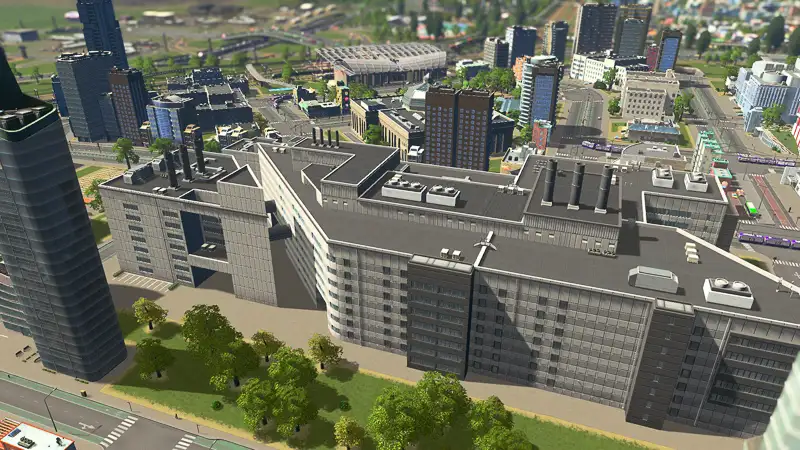
Getting started with the new Campus areas will be familiar to anyone who has the Parklife or Industries expansions. First, zone a new Campus area (by opening the Districts and Areas tab and choosing Paint Campus Area) and place the administrative building of your chosen Campus type. At the most basic level, just add a set of dormitories (or any building in the ‘Education Buildings’ tab and you’re away!
There are three Campus types: the Trade School, Liberal Arts College and University. Each have a range of buildings and three Faculties to choose from.
The new universities effectively replace the previous single building. If you’re adding a Campus to an existing city, you’ll want to gradually move students over and close the current University buildings so that you benefit from tuition fee income.
As with parks and specialised industrial areas, there’s objectives to meet to level up. Levelling up grants increased fees per student and more students will come to study from other cities. Each university starts at Unrecognised, eventually hitting Prestigious. Unlike in Parklife and Industries, if you don’t maintain the objectives, you’ll actually lose levels.
It’s not possible to mix and match building types across Campus types. Campus zones are also on the same ‘level’ as Park and Industry zones, and can’t overlap (but they can overlap with District zones).
Effective Campus design
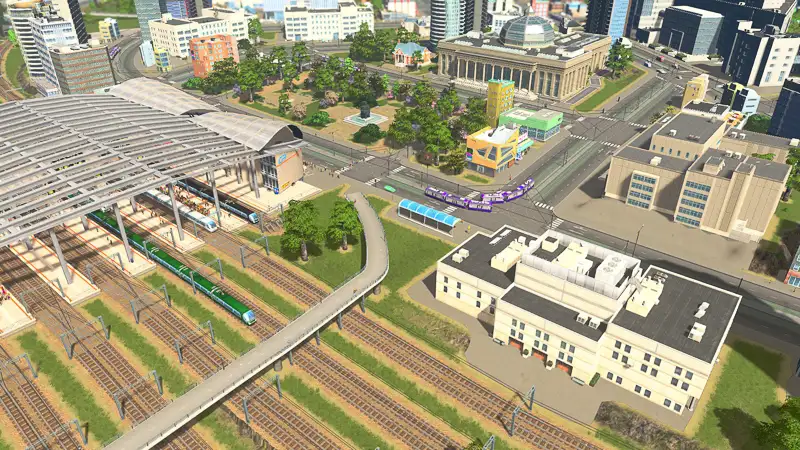
Campus buildings are, like in Parklife, able to snap to footpaths as well as roads (with the exception of the Administration building, which acts as a front door for things like garbage collection and police visits). That opens up opportunities to design stunning, leafy campuses with flowing footpaths and no traffic.
In general then, we can do whatever we want (which is awesome), but it is worth keeping in mind that each building houses a given number of students, and although I haven’t been able to test this, my sense is that students will gravitate towards buildings that are easy for them to reach - just as with elementary schools and ordinary universities.
So the implication is that having a pristine, out of town campus up on the hill, with only one public transport stop and some Campus buildings miles away, accessible only by footpath, will probably reduce student numbers.
It’s probably better, then, to make sure that key buildings like Faculties, are each served by good transport connections. As I’ll explain a bit later, one option is to spread your Campus buildings around, perhaps putting clusters of them around key transport connections, resulting in several ‘sub-campuses’. This approach does undermine the dream ‘mega campus’ a bit - but it’ll probably also be more effective.
Another thing to consider is that students will, for the first time, travel from other cities to attend your university. As with tourists, if it’s easy to reach their destination by train, outside visitors will leave the car at home, freeing up precious space on your roads.
The new city build order: universities early on
The Trade School unlocks first. On my map it was 7,500, although unlock levels do scale according to buildable area. Liberal Arts unlocked at 17,000 and University at 36,000. They also increase in price in that order. I’m not sure why that is: are the University perks stronger in effect? Their percentage impact isn’t listed. New buildings unlock as you level up, and you start with a handful of basic types and one faculty.
What’s great about this structure is that we can now add higher education to our cities much earlier than before. The standard University costs 75,000 to build and a massive 1,920 weekly upkeep for its huge 4,500 capacity. That’s wasted on a small town. But now, we can get a Trade School with 300 places going for 40,000 and 320 weekly upkeep.
That’s going to change the build order of our cities and mean we don’t need to wait until the late early-game before adding a university, and grow it steadily in line with rising demand.
This is a really good thing for the development of the city. We’ll now be turning out graduates much earlier than before, pushing up building levels (and tax income) and making office zoning viable years earlier than it normally is.
Maximising student numbers
It’s important not to put all your eggs in one basket. When I first started with Campus, I wanted one mega campus with every building and to send all my students there. What I noticed though, was an immediate drop in student numbers when I built a Campus in an existing city and deleted the existing University buildings.
In other words, it seems students are making a calculation about how far they’re willing to travel. If the new Campus is too far away, they won’t transfer - they’ll just skip higher education altogether and join the workforce.
I’m guessing a bit here (this is just based on observation, I’m not totally sure), but it also seems like once students join the workforce, they don’t leave it again when a nearby education option opens up - you need to wait for the next batch of high school graduates.
That’s a problem for your tax take (and garbage: less educated citizens produce more of it), and it’s a problem if you want your new university to reach the highest ‘Prestigious’ status, which depends on an permanent 1,800+ students.
Now I’ve played a bit more, I think there’s two good options:
- Make several smaller Campus-based universities, with one in each major population centre, or;
- Make one large Campus-based university, but paint a huge zone across the city, and create sub-campuses in each population centre, that all contribute to the same institution.
I think both work, and in the real world it’s not uncommon for city-based universities to be quite spread out, so from a flavour perspective it works. The way I see that working is each sub-campus could be based around one faculty, with a range of supporting buildings around it.
Be cautious about over expansion
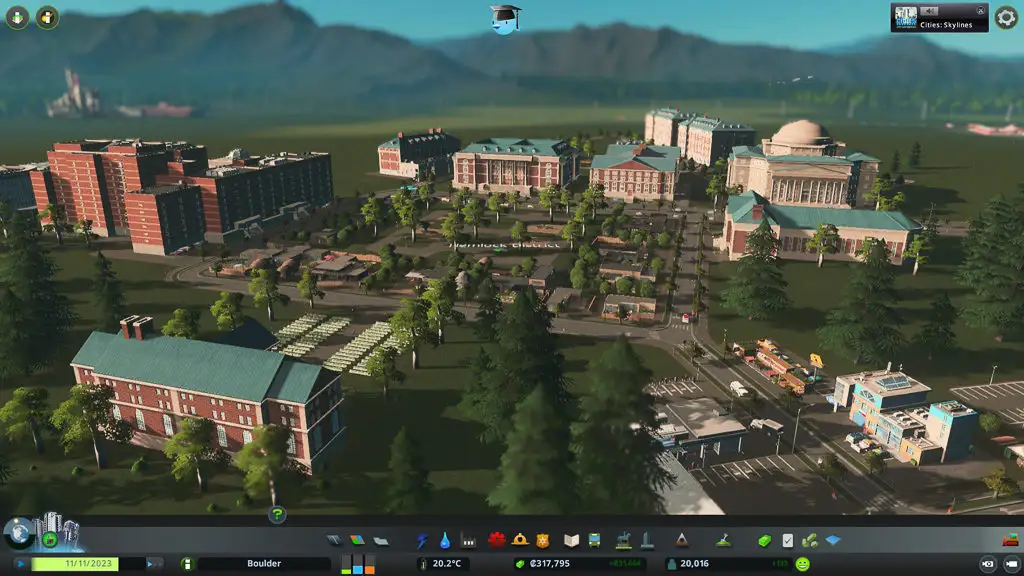
Keep in mind that demographics in the city change regularly. New people arrive, people grow up, move into the workforce, and die. This change in demographics is the force behind the Death Wave I’ve written about, and it also appears here.
I’ve watched in dismay as my newly ranked up university immediately loses its status as student number inexplicably plummet. I haven’t changed anything - it’s just that there are fewer eligible students for whatever reason.
So unless you’ve reached the point where money doesn’t really matter, it’s worth expanding steadily, rather than blowing it all on massive expansion to try to max out at Prestigious super quick.
Levelling up to Prestigious and Academic Works
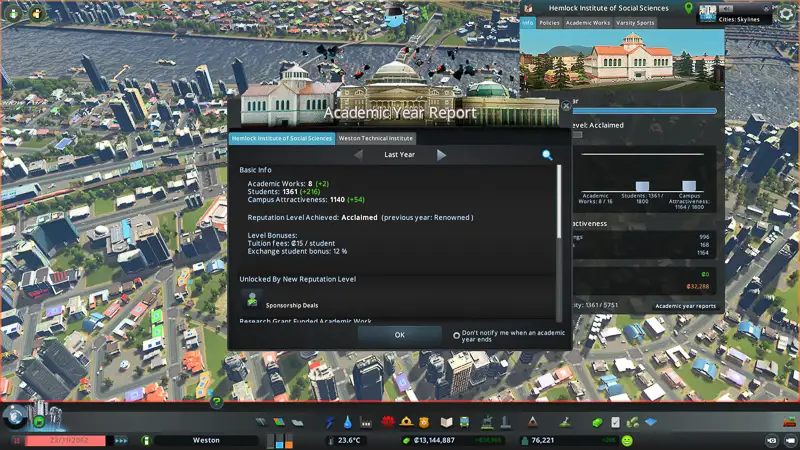
Taking your university from an unknown backwater college to an internally-recognised institution takes quite a bit of attention and a lot of time. Reaching each new stage requires a certain number of academic works, students and campus attractiveness. At the end of each academic year you’ll get a report showing progress - and don’t forget to check out the Commencement building where your graduates will be throwing their mortar boards into the air in celebration.
To hit Prestigious, you’ll need 16 Academic Works, 1,800 students, and 1,800 attractiveness. Also, levels don’t only go one way. Unlike your Nature reserve from Parklife, if you drop below the required student numbers, you’ll lose a level at the end of the academic year.
Let’s talk about Academic Works first, since it’s a new mechanic. At the end of each academic year, universities can produce new works. There is a percentage chance (revealed on the info panel) per 500 students. This will increase as you add new buildings, and you can speed it up by moving the academic staff slider. There’s also the academic grant, which costs 50,000, and guarantees one academic work that year. That’s a great way of speeding things up early on, and much cheaper than buying extra staff.
Just one more thing about Academic Works. We now have the Technology Museum, Art Gallery and Science Centre. They work like ordinary museums from the Unique buildings panel, except they can also house Academic Works, and their benefits are boosted for each new one they get.
I’ve talked about student numbers in the last section, but it’s important to restate that you must maintain your numbers or drop a level. Here, you’re at the mercy of demographic changes. If lots of students graduate in one year and aren’t immediately replaced, you might fall below the requirement temporarily.
Campus Attractiveness and Varsity Sports
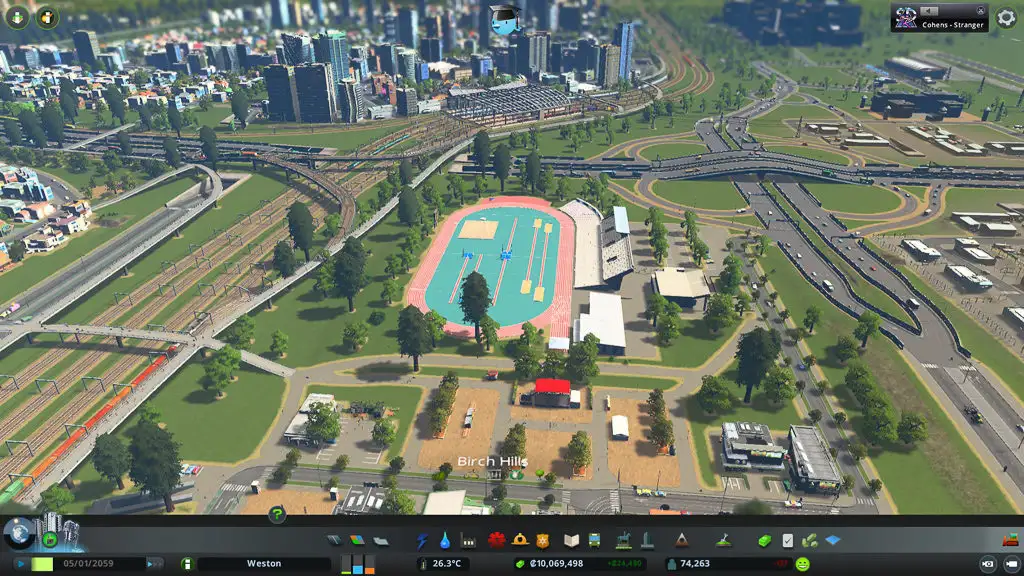
The Parklife Attractiveness mechanic makes a return here. New Campus buildings each boost attractiveness by a given amount (which isn’t stated on the tooltip, unfortunately), and reaching each new level largely depends on simply placing extra buildings like Libraries, Media Labs and Clubs.
However, there’s a welcome new mechanic. The DLC introduces five huge sports arenas that host Aquatics, Basketball, Track and Field, Baseball and American Football. They work similarly to the Stadium from the free Match Day DLC. They regularly host inter-city matches which draw large crowds and give happiness and financial benefits each time you win.
The difference with these arenas is that if you include them within the painted Campus zone, they become home to a Varsity team made up of university students instead. This links your sporting success to the campus and wins (and losses!), trophies and range of sports are all tallied up and added to the Campus Attractiveness score.
As an aside, as I mentioned in my review of Campus, I really like that the devs have begun interlinking these systems a bit better, and I hope we see more of that in the future and in Cities: Skylines 2!
Nine Faculties to help improve the city
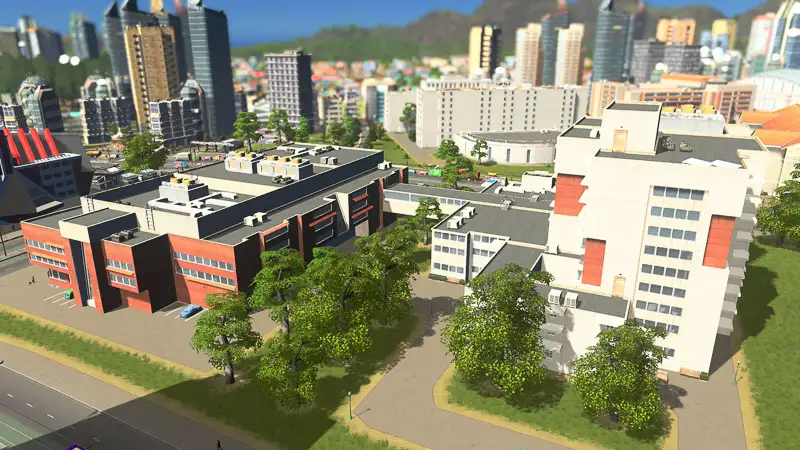
The new faculties - three per campus type - all have a specific perk that will help boost city services or income. This is great, as it really help tie the game’s mechanics a bit closer together, and give the satisfaction of really leaning into a particular city specialisation.
When you start the Campus, you have access to the first Faculty, and unlock the second and third as you level up. Each one can serve a maximum 1,000 students.
I’ve listed each faculty below and copied out its in-game tooltip. As you can see, they increase in price, but I’m not sure if that’s just for flavour or tied to the power of each perk. That said, given how easy health and crime are to manage, I’d say the much cheaper School of Tourism and Travel is going to be a lot more useful than the School of Medicine - but again, it depends what you specialise in.
Trade School Campus Faculties
Police Academy Upkeep: 1,200. Build: 75,000
During the studies cadets work with police officers and also keep an eye on the jail cell occupants, increasing patrol car counts, jail capacity and Police Department efficiency.
School of Tourism and Travel Upkeep: 1,360. Build: 85,000
Interns bring the best out of city attractions and shops, increasing attractiveness and entertainment of leisure buildings. Income from all commercial zones is increased.
School of Engineering Upkeep: 1,520. Build: 95,000
Students help local businesses with innovative solutions for higher product quality, increasing all generic zoned industry income while reducing city water consumption and sewage outlet.
Liberal Arts Campus Faculties
School of Education Upkeep: 1,600. Build: 100,000
Faculty provides all schools with an influx of substitute and student teachers which allows classrooms to have higher student capacity and helps them educate more efficiently. Faculty increases campus attractiveness and requires a Liberal Arts campus area.
School of Environmental Studies Upkeep: 1,760. Build: 112,000
Faculty encourages students to enlighten the masses about the negative effects of consumer culture on nature, reducing garbage accumulation in the city. Faculty increases campus attractiveness and requires a Liberal Arts campus area.
School of Economics Upkeep: 1,920. Build: 126,000
Through innovative budget planning and tax management, students from School of Economics help the local office zones increase revenue without upsetting the city’s populace. Faculty increases campus attractiveness and requires a Liberal Arts campus area.
University Campus
School of Law Upkeep: 2,080. Build: 133,000
Students get internships in the office of the city’s prosecutor, providing legal counsel to citizens. Crime rate and Police Department upkeep is reduced throughout the city.
School of Medicine Upkeep: 2,400. Build: 150,000
Faculty prepares interns to help out at the local clinics and hospitals, allowing city healthcare to run more efficiently with increased ambulance count and patient capacity.
School of Science Upkeep: 2,560. Build: 165,000
New technologies allows to gain an edge in the highly competitive marketplace. Income from all specialized industries is increased while reducing city pollution and electricity consumption.
Plug the gap with Public Libraries
Before I finish, I just wanted to reiterate something I mentioned in the review. The free patch the launched alongside Campus introduced the Public Library. It’s a really useful addition that gives adults an opportunity to gain education after they’ve passed school age. I think this is extra handy in the early game, when all your adults move in uneducated and are too old to start school, meaning they can’t take jobs in office zones, for example.
The Library means some of your residents will be able to level up even without attending school, which makes office zones and higher ranked industrial zones viable much sooner than they used to be.
Have fun building campuses! The DLC is pretty new, so if there’s intricacies I’ve got wrong here, or if there’s things you’d like me to cover, let me know!